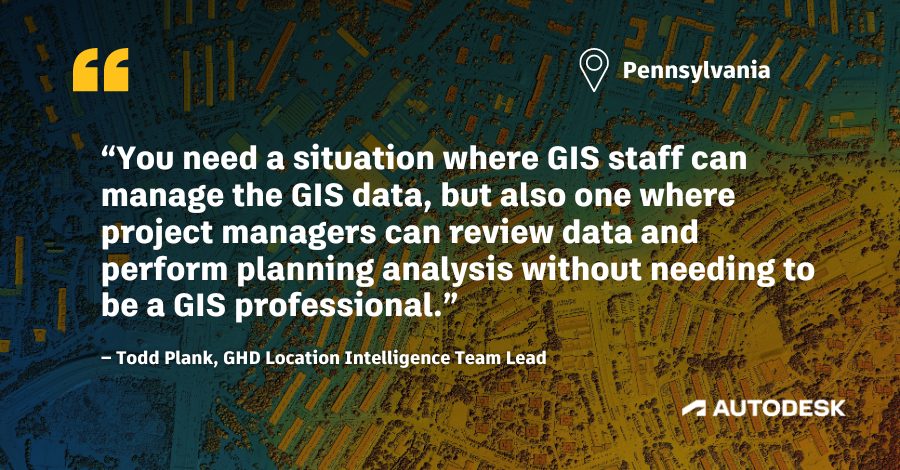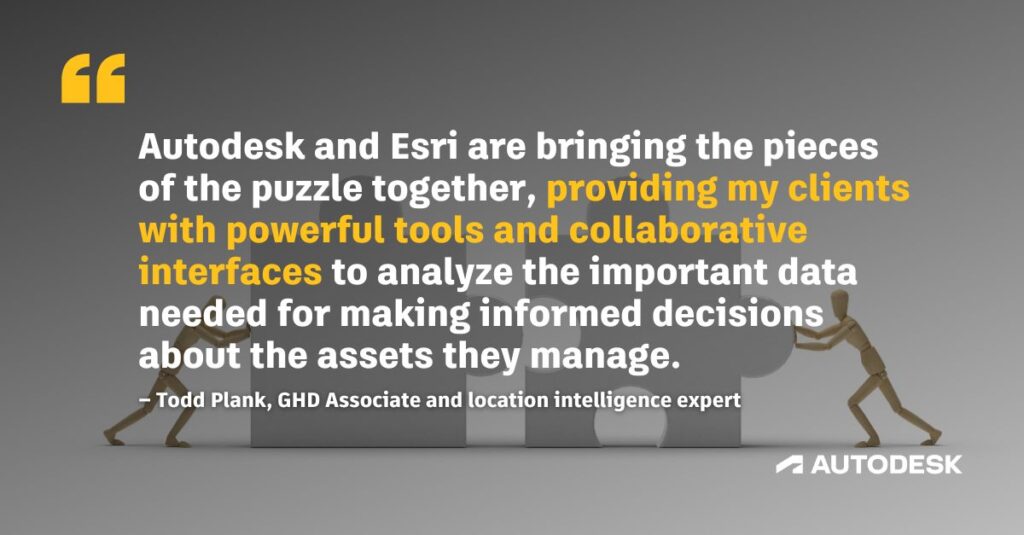& Construction

Integrated BIM tools, including Revit, AutoCAD, and Civil 3D
& Manufacturing

Professional CAD/CAM tools built on Inventor and AutoCAD
9 min read
Aqua Pennsylvania provides water and wastewater services to 32 counties across Pennsylvania and operates more than 50 wastewater systems. They face the same challenges many water utility owners across the globe also face: finding ways to efficiently maximize the management of aging infrastructure.
In 2023, they turned to GHD to help them create a system to manage the volumes of data to make decisions for pipe rehabilitation and Capital Improvement Planning (CIP). The first point of order was addressing the dispersal of their data sources for condition assessment data. They wanted to find a compelling solution that could scale.

“GHD previously performed a prioritization project with inspection data for a single sewer system,” says GHD Location Intelligence Team Lead Todd Plank. “Aqua approached us on how to manage and utilize this data across all the systems for the Pennsylvania Main Division to help with capital planning.”
Plank envisioned a system where Aqua could manage all their CCTV data, using it for planning and budgeting purposes across many systems, with managers, in-house CCTV inspectors, contract CCTV inspectors, and other contractors utilizing the data. Ultimately, he wanted Aqua to be able to use all this data for CIP planning at a state, regional, and local level. It was a tall order, and one that encouraged Plank to consider tying two systems together – one from Autodesk and one from Esri – to create a system useable by all system managers across the state.
Todd Plank is always looking for efficiencies. He has a 30-year history of using all manner of GIS systems to track underground assets in his native Pennsylvania and for clients around the world. “I went to college to be a teacher and ended up taking a GIS class back in the early 90s, when GIS technology was just starting to expand,” he says. “It seemed like the other engineering students either aced it or failed miserably. Many of them could simply not understand the concepts, but I was good at it. I could see the patterns that came out of GIS, and particularly its application in analytics. So I just rode that wave.”
That wave continued to roll on, with GIS proliferating and eventually becoming the backbone of mapping for countless web technologies. Thirty years later, GIS is ubiquitous. It’s used to map deforestation, to track disease outbreaks, to visualize demographic changes, to predict food shortages, and, of course, to map the infrastructure that keeps the built world running. “GIS data is central to sewer asset management and planning, and maintaining that data is a continual process,” says Plank. It’s so ubiquitous that operating a water utility today without using GIS would be practically impossible.

Plank is also a veteran of the promises and pitfalls of CCTV pipe inspection, which has become the most reliable way for water utilities to collect data on where defects like holes, blockages, and cracks might be, as well as to identify maintenance issues like build-up of grease. The technology to capture CCTV keeps improving as more nimble and more rugged remote-controlled robotic devices proliferate, but no matter how advanced these devices become, the most important work – making smart decisions about pipe rehabilitation – will still need to be done by the humans who use the software that interprets all the data that CCTV robots capture.
The software that captures and analyzes CCTV footage is also improving, being made more accurate and efficient, sometimes by using it in conjunction with Large Language Models. In fact, CCTV footage interpretation may be one of the most clear and straightforward use cases for AI and Machine Learning in the water industry (VAPAR is already solving this problem) because there’s an enormous supply of video being captured every day.
“Aqua has volumes of CCTV data, millions of linear feet of data, and they are constantly producing more inspection data of their systems,” says Plank. The problem is, many utilities struggle with organizing and utilizing all that data, which was the first issue he wanted to solve for Aqua.

The first step in implementing a successful CCTV inspection program is gathering and organizing all your CCTV footage in one platform. While that may seem simple, the truth is that in many water utilities, CCTV footage can be all over the place, for a variety of systemic reasons.
Sometimes field workers don’t always have clear processes established for collecting and storing CCTV data. Sometimes, analysts get overwhelmed by the sheer amount of footage collected and push out regular CCTV analyzation from a monthly schedule to dealing with it quarterly or yearly instead. IT teams may try to make things easier by establishing a place to archive the data, but if the files have inconsistent naming, formats, or different organizational schemes, workers might become frustrated with the inconsistencies and simply use that location as if it were one big folder to dump back-ups and archives of their footage “in case we need it someday.” (Sound familiar?)
“Typically, the files are delivered from the field on a portable storage device, resulting in data squirreled away in various office drawers, filing cabinets or copied to arbitrary folders on a server,” says Plank. “Not the easiest way to utilize volumes of data.”
To make CCTV really work, as Todd sees it, you need to be extremely organized and design clear processes and procedures around managing your data, but you also need to make it easy for people to access. “You need a situation where GIS staff can manage the GIS data, but also one where project managers can review data and perform planning analysis without needing to be a GIS professional.”

The solution GHD implemented for Aqua utilizes Esri’s ArcGIS Online platform integrated with Autodesk’s Info360 Asset. Leading a team of ArcGIS Online administrators, Plank has become highly attuned to working with GIS through Esri’s web-based systems so he sees next-generation Info360 Asset’s SaaS roots and Esri integration capabilities as a big positive with regards to democratization of data.
“The former InfoAsset Planner was an extension to Esri’s ArcMap desktop GIS software, so you needed a GIS professional to use the software. And then you also needed somebody who knew risk assessment and project prioritization and how to use those tools. Now, with Info360 Asset, non-GIS users have the tools to go in, set up risk models and decision trees and generate results.”
Info360 Asset is a SaaS cloud platform that provides a centralized database where users can store, access, and analyze information on their assets such as pipe attributes, inspection data, and risk and rehabilitation models, all of which can be shared across the organization, providing managers with the tools to collaborate and keep their asset management programs moving forward in a predictable and understandable way:



Those informed decisions can be made easier and more confidently by the decision tree functionality, which gives workers a replicable mind map for processes and procedures that need to be followed. With these decision trees, questions are asked of the data, which places specific assets into ‘buckets’ or actions based on a combination of attributes, condition, risk, and cost-based analysis to identify proposed actions.
For example, you might create a decision tree to identify priority pipes for a lining contract in 2024 for an individual sanitary sewer system. Since Aqua is looking at multiple different systems, they can filter out results based on a named system. But they can also use these for understanding CIP budget allocations by individual system, division, or the entire state.
Even better, the results from both the risk analysis and rehabilitation decision trees can be visualized not just within Info360 Asset but also via ArcGIS Online because the data is updated bi-directionally. As model results change within Info360 Asset, those results are updated utilizing feature layers within ArcGIS online.
“The integration of Info360 Asset with Esri’s ArcGIS Online platform is opening doors to data collaboration among many users within an organization,” says Plank. “Not only can users view the data within Info360 Asset, but customized Dashboards and Web Maps within ArcGIS Online can also consume and be updated with results from Info360 Asset.”

Developing risk models in Info360 Asset will be familiar to seasoned water professionals, and it’s all available online, in a browser, in one central location:
Once the model is run, you see the results for each asset, in both tabular and spatial formats, giving you a much better understanding of your risk and what needs to be done to mitigate it.
There is another very important component to Aqua’s CIP plans, one that Plank is counting on Info360 Asset to deliver. Aqua must submit long-term infrastructure program plans to the Pennsylvania Public Utility Commission, which detail where they plan to invest in infrastructure. Having all that data ready to export and submit via custom-made reports can make a big difference in satisfying regulators. As Plank puts it, “The more and better data you have to make those decisions, but also to present and justify and convince people that this is the prudent way of spending the money, the better off you will be.”

With the combination of Esri and Autodesk’s Info360 Asset, GHD has set Aqua up with a streamlined, efficient process for managing GIS and inspection data, with tools for risk analysis and decision-making to generate results – both tabular and spatially – that can be used in the planning process for infrastructure improvement. “Autodesk and Esri are bringing the pieces of the puzzle together, providing my clients with powerful tools and collaborative interfaces to analyze the important data needed for making informed decisions about the assets they manage,” says Plank.
Sign up for the One Water Blog newsletter, and we'll keep you updated about our top stories, along with the best content we find online. We only send out a newsletter when we have something interesting to share.
May we collect and use your data?
Learn more about the Third Party Services we use and our Privacy Statement.May we collect and use your data to tailor your experience?
Explore the benefits of a customized experience by managing your privacy settings for this site or visit our Privacy Statement to learn more about your options.